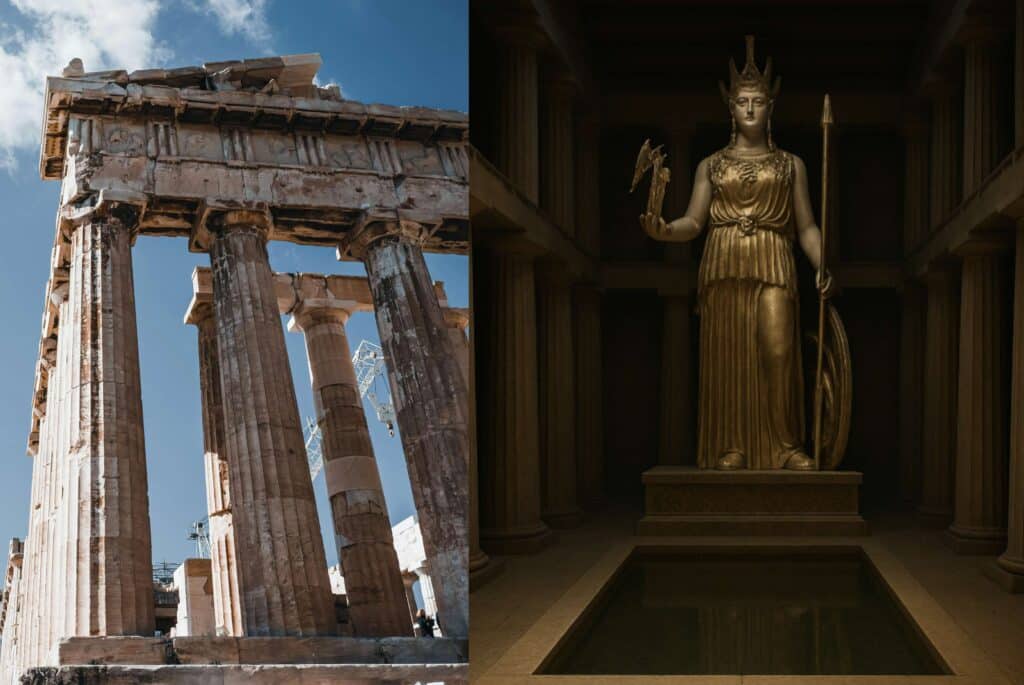

You think you know the Parthenon, Greece’s ancient marvel, but do you know it so well as to know that it had a pool inside it?
The iconic image we all have—those sun-drenched, majestic columns standing proudly over Athens—is missing an unbelievable detail from its original form: water. Yes, you read that right. Inside the temple dedicated to Athena Parthenos, it wasn’t just stone and gold, but an actual pool filled with water.
Forget the postcard view for a second, the one every visitor from Athens has in his or her mind. Let’s imagine that we could go inside, to the naos, the main room of this incredible ancient structure. This is now a space, but that was not the case in antiquity. It was the home of the massive statue of Athena Parthenos, a mind-blowing creation by the one and only Phidias.
The impressive statue was massive and genuinely awe-inspiring—almost 12 meters (about 40 feet) tall! And the most important thing of all, it was made of gold and ivory. Sounds unique, right? But here is the crucial detail about ivory: it’s a proper diva. It hates dry air. It can crack, warp, and throw a massive materialistic tantrum if the humidity isn’t to its taste. So, what did the Athenians, led by Pericles and Phidias, do? They came up with a solution that seems almost crazy today.
Right there, on the exceptionally shiny marble floor in front of the giant statue of Athena, lay a shallow pool of water. This was not a public pool for worshipers to swim in. Nor was it the Acropolis Athletic Club of antiquity. Instead, this pool served as a clever method to control the climate inside and ensure the fragile ivory remained in optimal condition year-round. The water slowly evaporated, maintaining the naos at an optimal humidity level, protecting Athena’s delicate ivory parts from drying out, cracking, and potentially collapsing. It was like 5th-century BC air conditioning, but in a more environmentally friendly way!
The practical use of this feature evokes impressive visuals. The water’s surface would shimmer, reflecting the gold from Athena’s armor, the painted ceiling, and any incoming light. This effect would enhance the divinity of the statue, adding an extra layer of admiration for worshipers. One could argue that it served a dual purpose, akin to special effects, enhancing the sacred atmosphere.

Intriguingly, this is not common knowledge. Why aren’t tour guides sharing more about the Parthenon’s indoor water feature? The reason is complex. Over the centuries, changes in authorities have occurred, and gradually, the structure has deteriorated, reducing the Parthenon to its bare bones. The incredible gold and ivory statue of goddess Athena? Gone, probably looted or destroyed centuries ago. Without the statue, the pool’s main reason for existing went away.
The pool itself, probably just a shallow area lined with some local stone, left only faint traces that are easy to miss, especially with all the temple being turned into a church, then a mosque, and then that unbelievable explosion in 1687. We’re all used to seeing the Parthenon as this amazing ruin, with the perfect column shape and the roof. It’s easy to forget this was a working building, full of color, treasures, and yes, even a carefully controlled environment with its humidity levels. We see it as a beautiful ruin, but we forget it was once full of life, purpose, and clever ideas, like that pool inside.
Even after thousands of years baking under the Greek sun, the Parthenon still has secrets to share. That forgotten pool is one of the many intricate details we don’t see today, but it is there, proof of the masterful world of ancient Athens.
